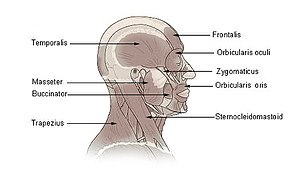Masseter muscle
| Masseter muscle |
|---|

|
| Head and neck muscles of humans |
| origin |
|
Pars superficialis : anterior and middle third of the zygomatic arch Pars profunda : |
| approach |
| Masseteric tuberosity of the lower jaw |
| function |
| Raise and move the lower jaw sideways |
| Innervation |
| Masseteric nerve of the mandibular nerve |
The masseter muscle (short: masseter; Latin for "chewing muscle") is one of the four chewing muscles of mammals . It arises in humans on the zygomatic arch ( arcus zygomaticus ), in many other mammals also on the crista facialis of the upper jaw , and inserts at the angle of the lower jaw . In addition to the actual jaw closure, the muscle also allows sideways and longitudinal movements of the lower jaw and thus ensures that the food is ground. The masseter, like the other masseter muscles, is derived from the first branchial arch and is therefore innervated by the first branchial arch nerve, the mandibular nerve.
In humans, blood is supplied by the masseteric artery (a branch of the maxillary artery ) and the transversa faciei artery . In veterinary anatomy, the inflow from the external carotid artery in ungulates and carnivores is called the ramus massetericus .
The parotid duct runs through the masseter muscle .
Food aspects
In herbivores and omnivores, and therefore also in humans, the muscle is very strong, but very feathery and heavily permeated with tendon tissue . Therefore, the meat is of poor utility. For this reason, cuts are made on the cattle masseter during the meat inspection so that they can be examined for tapeworm fins. The head meat (including masseter) of the pig is only used for the production of jellied meat ( "pork head jelly ").